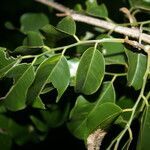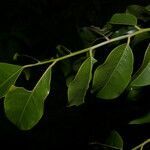Tree to 40 m tall, d.b.h. ca. 1 m; bark smooth, with abundant lenticels. Leaves usually imparipinnate, 5-10 foliolate; rachis and petiolules pubescent, terete; rachis 5-15 cm long; leaflets alternate, lanceolate to elliptic, acute to acuminate, obtuse at the base, 3-11 cm long, 1.8-4.0 cm wide. Inflorescence racemose, axillary, to 20 cm long, closely cinereous tomentose; pedicels 1.0-1.5 cm long. Flowers oblique on the pedicel; calyx campanulate, 1.5-4.5(-6.0) mm long, finely ribbed, the lobes ca. 1.5 mm long; the standard orbicular, ca. 9 mm in diameter, cordate basally, the claw ca. 1 mm long; wings elliptic to narrowly spatulate, ca. 1 cm long, ca. 4 mm wide, the claw 2 mm long; keel subelliptic, ca. 8.5 mm long, ca. 3 mm wide, the claw ca. 1.5 mm long; ovary short stipitate for ca. 2 mm, villosulose; style subulate. Fruit a samara, narrowly obovate, to 11 cm long, glabrous, stipitate, ca. 1 cm long; wing to 8,cm long, 1-2 cm wide, the seminif-erous area turgid at the apex of the fruit, obliquely oblong, 2-3 cm wide, ca. 1 cm thick.
More
A tall tree. It can be evergreen or deciduous. It grows 35 m tall. It is stiffly erect. Large trees can have small buttresses. The leaves are mid green and have leaflets along the stalk. There are 3-13 leaflets. These are oval and 9 cm long. They are glossy. The flowers are small and white. They are in hairy racemes. They have a sweet scent. The fruit is a pod 7.5 cm long. It is tear drop shaped and winged. It has one seed.
Tree with 5–11(–15)-foliolate leaves.. Lateral leaflets alternate, oblong-ovate to-elliptic, acuminate, with pellucid dots and streaks.. Flowers in racemes, whitish, 1–1.2 cm. long; anthers nearly as long as the filaments, conspicuous.. Fruit flattened and wing-like, broadened, hardened and 1-seeded at the apex, indehiscent.
The fruit are used to flavour rum. The trunk provides a resin and essential oil used for flavouring chewing gum, baked goods, candies, ice cream and soft drinks.



